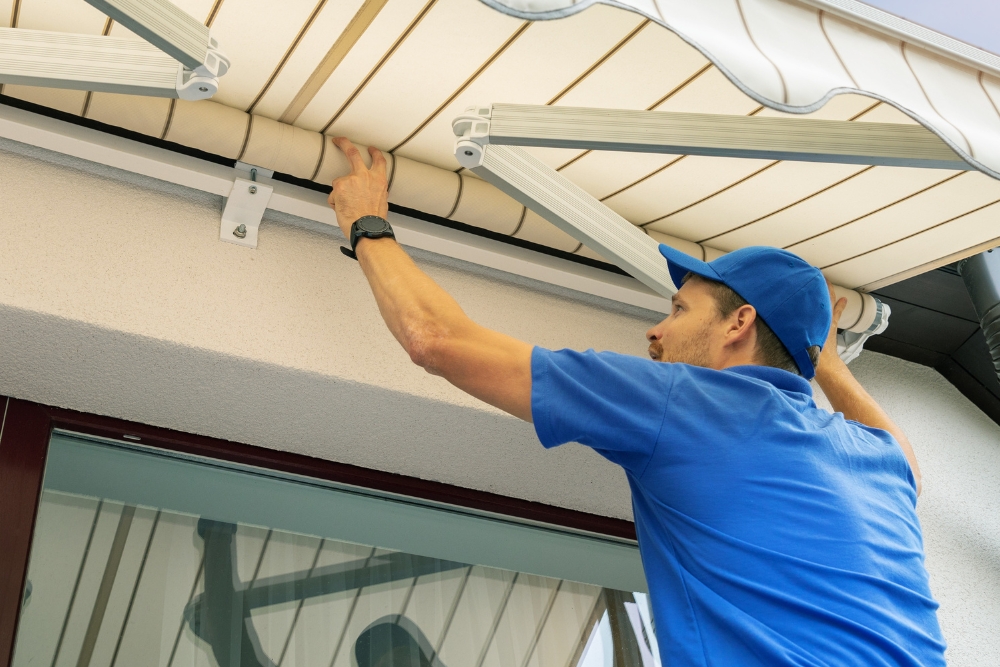Awnings are a popular addition to homes and businesses in The Hunter region. They not only provide shade and protection from the elements but also enhance the overall appearance of the property. To keep your awnings looking their best and functioning effectively, regular maintenance and cleaning are essential.
In this comprehensive guide, we’ll walk you through the steps of awning maintenance and cleaning in The Hunter, ensuring your awnings remain in top condition for years to come.
Understanding your awnings
Before diving into the cleaning process, it’s crucial to understand the type of awnings you have. The most common types of awnings include:
Retractable awnings
Retractable awnings are adjustable and can be extended or retracted as needed. They are typically operated either manually with a crank or automatically with a motor. Retractable awnings provide the flexibility of controlling shade and exposure to sunlight.
Fixed awnings
Fixed awnings, as the name suggests, are stationary and cannot be adjusted. They are securely attached to the building and provide constant shade and protection.
Fabric awnings
Awnings are often made of fabric materials such as acrylic, polyester, or vinyl. Fabric awnings require regular cleaning and maintenance to prevent mould, mildew, and fading.
Metal awnings
Metal awnings, commonly made from aluminium or steel, are durable and low maintenance. However, they still require periodic cleaning to remove dirt and grime.

Regular cleaning and maintenance
Dusting and brushing
Start your awning cleaning routine by dusting and brushing off any loose dirt and debris. Use a soft brush or broom to gently sweep away leaves, dust, and cobwebs from the awning’s surface. Regular dusting prevents dirt from accumulating and makes the deeper cleaning process more manageable.
Washing fabric awnings
For fabric awnings, washing is essential to keep them looking fresh and prevent mould and mildew growth. Follow these steps for washing fabric awnings:
- Prepare a cleaning solution by mixing warm water with a mild detergent. Avoid using harsh chemicals that may damage the fabric.
- Test the cleaning solution on a small, inconspicuous area of the awning to ensure it doesn’t cause discoloration.
- Using a soft bristle brush or a sponge, gently scrub the awning with the cleaning solution. Pay special attention to any stains or spots.
- Rinse the awning thoroughly with clean water to remove all soap residues.
- Allow the awning to air dry completely before retracting or folding it back in.
Cleaning metal awnings
Metal awnings are relatively low maintenance but still require periodic cleaning to remove dirt and grime. Follow these steps for cleaning metal awnings:
- Prepare a cleaning solution by mixing warm water with a mild detergent or a few drops of dish soap.
- Use a soft cloth or a sponge to apply the cleaning solution to the metal awning.
- Gently scrub the surface, paying attention to any stubborn stains or spots.
- Rinse the awning thoroughly with clean water to remove all soap residues.
- For stubborn stains or hard-to-reach areas, consider using a pressure washer on a low setting. Be cautious not to use excessive pressure to avoid damaging the awning.
Mould and mildew removal
If you notice mould or mildew on your awning, it’s crucial to address the issue promptly. Mould and mildew not only detract from the awning’s appearance but can also lead to structural damage over time. To remove mould and mildew:
- Prepare a mixture of equal parts water and white vinegar—a natural antifungal and antibacterial agent.
- Apply the vinegar solution to the affected areas and let it sit for about 15 minutes.
- Gently scrub the area with a soft brush or sponge to remove the mould and mildew.
- Rinse the awning thoroughly with clean water to eliminate any vinegar residue.
- Allow the awning to air dry completely.
Seasonal cleaning
In addition to regular cleaning, consider giving your awnings a more thorough cleaning at the beginning of each season. Seasonal cleaning will help remove any accumulated grime and prepare the awnings for changing weather conditions.
Spring cleaning
As spring arrives in The Hunter, it’s an ideal time to clean your awnings and prepare them for the warmer months ahead. Spring cleaning should include dusting, washing, and inspecting the awnings for any damage or wear.
Summer maintenance
During the summer months, awnings are subjected to increased sun exposure and potential harsh weather. Regularly check for signs of fading or deterioration and address any issues promptly. Apply UV protectant sprays to fabric awnings to prevent sun damage.
Autumn cleanup
In preparation for the cooler weather, give your awnings a thorough cleaning in the fall. Remove any fallen leaves or debris from the awning’s surface and ensure the fabric or material is dry before retracting or storing the awning for the winter.
Winter care
During the winter months, retractable awnings should be fully closed and secured to protect them from snow, ice, and strong winds. Fixed awnings should be inspected for any loose fasteners or structural issues that may require repair before the harsh weather sets in.
Storing retractable awnings
If you have retractable awnings, consider storing them during the off-season or when not in use for extended periods. Storing the awnings will prolong their lifespan and protect them from potential damage caused by severe weather.

Clean before storage
Before storing a retractable awning, ensure it is clean and free of any debris or moisture. Cleaning the awning ensures that no dirt or grime will be trapped during storage, preventing mould and mildew growth.
Retract fully
Retract the awning fully before storage. Leaving the awning partially extended during storage can lead to damage caused by wind or heavy snow.
Store in a dry location
Store the awning in a dry location, such as a garage or shed, to protect it from rain, snow, and other environmental factors.
Protect the fabric
If your retractable awning has fabric, consider using a protective cover or storing it in a clean, dry bag to shield the fabric from dust and debris during storage.
Inspecting for damage
Regularly inspect your awnings for any signs of damage, wear, or tear. Check the hardware, fasteners, and connections to ensure they are secure. If you notice any issues, address them promptly to prevent further damage and ensure the awnings’ longevity.
Professional cleaning and maintenance
While regular cleaning and maintenance are essential, there may be times when your awnings require professional attention. Professional cleaning services can deep clean your awnings, remove tough stains, and apply protective coatings to prolong their life.
Keep your awnings clean all year round
Maintaining and cleaning your awnings in The Hunter is essential for their longevity and optimal performance. Regular dusting and periodic washing will keep your awnings looking fresh and prevent the growth of mould and mildew. Seasonal cleaning and proper storage will prepare your awnings for changing weather conditions.
By following the tips and steps outlined in this guide, you can ensure your awnings not only enhance the aesthetics of your property but also provide reliable protection and shade for years to come.
Take the first step towards awning maintenance and cleaning today. Regularly clean and inspect your awnings to ensure they remain in top condition and continue to enhance your home’s beauty and functionality. Properly cared-for awnings can provide years of enjoyment and comfort for your family. By investing time in maintaining your awnings, you’ll protect your investment and contribute to the overall appeal and value of your property. Get started with awning maintenance today and enjoy the benefits for years to come!

